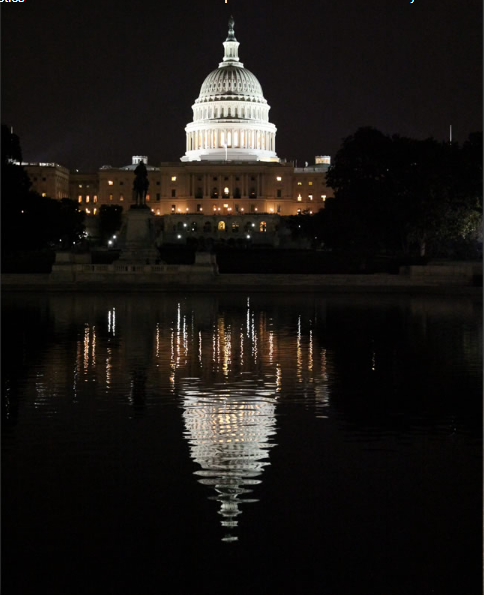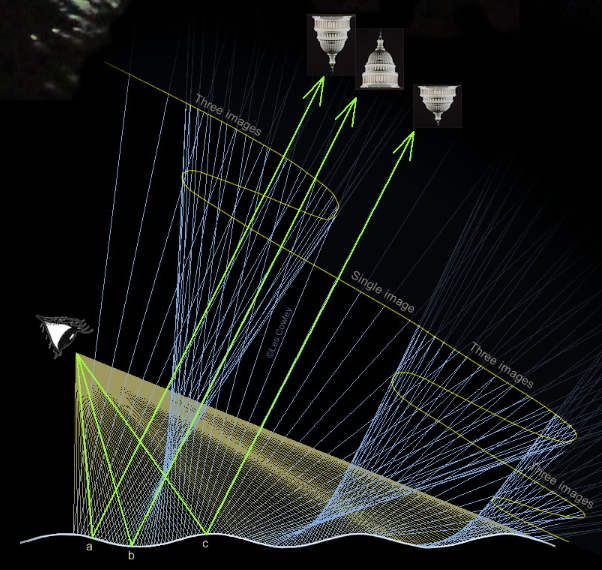OPOD - Capitol Reflections
OPOD - Capitol Reflections: A Detailed Look at the Phenomenon
When Glenna Bayer captured the image of the Capitol building reflected in the aptly named Capitol Reflecting Pool in Washington, D.C., she unknowingly captured a mesmerizing optical phenomenon. The inverted dome of the Capitol stands out prominently in the overall Daliesque pattern, but upon closer inspection, there is much more to discover. In this article, we will delve into the intricate details of the reflection and explore the fascinating puzzle it presents.
The Intriguing Puzzle of Capitol Reflections
The concept of how we see objects has intrigued scholars throughout history. Many ancient Greeks believed that we see objects through rays emitted from our eyes. This notion provides a useful framework for understanding the phenomenon of viewing the reflection of the Capitol building in wavy water.
In an accurately computed ray tracing representation, we observe a stream of rays emanating from the eye and interacting with sinusoidal cylindrical waves. Despite the seemingly chaotic nature of the reflections, there is a discernible order in their behavior.
Exploring the Ray Paths
Imagine three parallel green rays originating from the eye and pointing towards the distant first tier of columns on the Capitol dome. As the eye's viewing direction rises, the rays near point 'a' gradually lower. Consequently, an inverted image of the Capitol is perceived. On the other hand, rays near point 'b' maintain their direction as the eye's viewing angle increases, resulting in an upright image segment of the building. Point 'c' mirrors point 'a' and produces another inverted image, intensified by the convex surface near it. Thus, each wave gives rise to three closely spaced images of the same Capitol slice: two inverted and one upright.
A Stack of Pancake Slices
The overall reflection of the Capitol in the water resembles a stack of pancake slices, with some flipped upside down and others right-side up. The thin and fat alternations and mirroring of neighboring slices add to the intriguing complexity of the pattern. However, it is important to note that the behavior of the reflection is not static. Any movement in the water caused by wind or other factors introduces a dynamic element, causing the pancakes to tilt, twist, and contort in fascinating ways.
Delving Deeper into Capitol Reflections
The captivating image captured by Glenna Bayer is a testament to the enchanting world of atmospheric optics. By studying the intricacies of the reflected image, we gain insight into the physics behind the phenomenon. The combination of the Capitol building's unique architecture and the interplay between light and water waves creates a visual spectacle that continues to fascinate both scientists and casual observers.
As we delve deeper into the world of atmospheric optics, it is worth noting that this article has been automatically converted from an older website and may not appear as originally intended. For more information and the original article, please visit the provided link.
Conclusion
The phenomenon of Capitol Reflections offers a glimpse into the captivating world of atmospheric optics. Glenna Bayer's photograph captures not only the inverted dome of the Capitol but also the intricate details of the reflection. By understanding the behavior of rays interacting with wavy water surfaces, we can unravel the puzzle of this mesmerizing optical phenomenon. Whether it's observing the stacked pancake slices or witnessing their contortions caused by wind-induced water movement, Capitol Reflections provides a visual feast for all who appreciate the beauty and complexity of nature's interplay with light.

Capitol Reflections - Glenna Bayer pictured the Capitol, Washington, D.C. reflected by the aptly named Capitol Reflecting Pool. The Ulysses S. Grant Memorial is the statue silhouetted by the floodlit building. Images ©Glenna Bayer, shown with permission.
The overall Daliesque pattern is recognisably the inverted Capitol dome. The detail is stranger. The stacked pancakes sometimes alternate thin and fat and sometimes mirror a neighbour. More is happening than simple reflection. See below...
Puzzle view
 Many (but not all) Greeks held that we see objects by rays emitted from our eyes.
Many (but not all) Greeks held that we see objects by rays emitted from our eyes.
This is a convenient way to understand what happens when we look at the Capitol's reflection in wavy water.
At left, in the accurately computed ray tracing, a stream of rays leave the eye and impinge on sinusoidal cylindrical waves. The beams are reflected in all directions yet there is order in how they behave.
Imagine that the three parallel green rays point to the distant first tier of columns on the wedding cake of the Capitol dome.
The rays near 'a' point lower and lower as the eye viewing direction is raised. The eye therefore sees an inverted image.
Rays near 'b' are different. They point in the same direction but as the eye viewing direction is raised the building section viewed is also raised. The Capitol image segment is upright.
Point 'c' is like 'a' and gives another inverted image. The surface near 'c' is convex and the image is strongly compressed in the vertical direction.
Each wave gives up to three closely spaced images of the same slice of the Capitol. Two slices are inverted and one upright. The overall reflection is a stack of pancake slices some tossed upside down and some the right way up.
Let the wind move the roughly cylindrical waves in a different direction and the pancakes tilt, twist and contort.

Note: this article has been automatically converted from the old site and may not appear as intended. You can find the original article here.
Reference Atmospheric Optics
If you use any of the definitions, information, or data presented on Atmospheric Optics, please copy the link or reference below to properly credit us as the reference source. Thank you!
-
<a href="https://atoptics.co.uk/blog/opod-capitol-reflections/">OPOD - Capitol Reflections</a>
-
"OPOD - Capitol Reflections". Atmospheric Optics. Accessed on November 26, 2024. https://atoptics.co.uk/blog/opod-capitol-reflections/.
-
"OPOD - Capitol Reflections". Atmospheric Optics, https://atoptics.co.uk/blog/opod-capitol-reflections/. Accessed 26 November, 2024
-
OPOD - Capitol Reflections. Atmospheric Optics. Retrieved from https://atoptics.co.uk/blog/opod-capitol-reflections/.